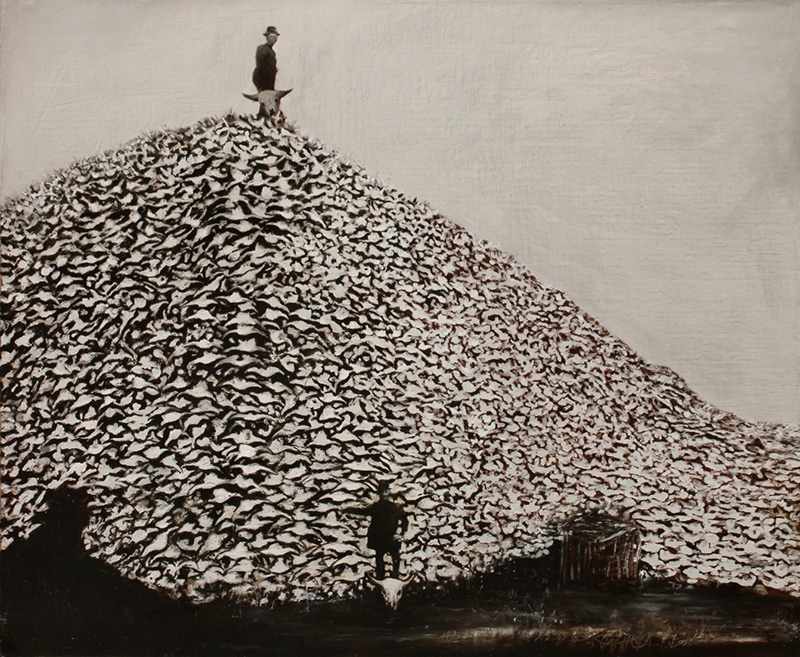CHRIS PFISTER: THE MONOCHROMES
October 19 – December 18, 2015






Big Dry Landscape
Artist Chris Pfister (b. 1957) began painting satirical versions of landscape works by European painters: Claude Lorrain, George Stubbs, and other artists. As his work has evolved and matured, Pfister has turned his attention from 18th century art to archival black-and-white photos. His greyscale paintings, the crux of a career spent exploring the forms and moods of old images, reflect the profound development of Pfister’s work that has taken place since the 1990s. Pfister has come into his own with a rich, compelling oeuvre dealing with unusual scenes in everyday American life.
Pfister selects his images from books, archives, and anywhere else that he finds something interesting. He creates and curates in such a way that the viewer revisits history and takes in moments memorialized from an artist’s viewpoint.

Elder
Once Pfister has found a compelling source, he paints his interpretation of the scene on canvas. That interpretation ranges from the humorous to the haunting, from the broadly historical to the deeply personal.

Young Astronomer
While Elder and Very Important Man slyly inject humor into once-serious scenes, Pfister is not just a satirist. Many of his paintings, like Young Astronomer and Picnic, add a poignant tone to the everyday, drawing our attention to the way photography freezes so many moments in time. As the Young Astronomer’s telescope lets him stare into space, so Pfister’s paintings allow us to marvel at the density of our history, infinitely packed with images, places, people and events. Pfister takes time to dwell on scenes others have forgotten, making something special of the everyday.

Picnic
Pfister’s work has a timeless quality: the scenes he chooses are free of modern technology, immersing us in a bygone era.

Irrigation
Source photo courtesy of: A.G. Lucier Collection, John T. Hinckley Library, Northwest College, Powell, Wyoming
The feelings these archaic scenes arouse may be happy, sad, or bittersweet. They are all certainly powerful—and they all testify to Pfister’s creative vision, because these paintings are not simply copies of photographs. In fact, Pfister’s masterfully tight brushwork belies his free flowing technique. He does not work from detailed traces or sketches of the images. What you see on the canvas is his unrestrained interpretation of the photograph.

Harvest
Source photo courtesy of: The Burton Historical Collection, Detroit Public Library
This unhindered process allows Pfister to transform these historical images into art objects, beautiful and entrancing in their own right and beyond their context. Harvest, for example, looks photographically real but also surreal, molded by the artist’s mind. The faces are blurred, suggesting the historical anonymity of the figures. And could there possibly have been such a big pile of buffalo bones? The answer, of course, is yes—part of the appeal of Pfister’s art is that the source photos themselves are so brilliantly bizarre.

Oil Field Aerial

Forks and Knives
Source photo courtesy of: photographer Wright Morris
Pfister also toys with the idea of the old photo itself. Many of Pfister’s scenes appear to be from the distant past even when they are relatively recent. Others, like Forks and Knives, are large paintings derived from blown-up versions of smaller photos. In our day and age, when people are exposed to thousands of photographs every day, Pfister’s reshapings make us slow down and reflect on what we are really seeing when we look at a picture.

Map #3
Spend a day at Chris Pfister’s Wyoming home, and you will understand why the artist feels inspired by the timeless West. The views are expansive and spectacular: rolling, golden hills that seem infinite. Pfister’s functioning cattle ranch, east of Yellowstone National Park, also houses the artist’s studio, tucked inside an unassuming building on the property.
The location seems to suit the frontier style of the painter and New-York ex-pat, who enjoys a rustic life with his family—and who makes all his own paints and oils. He has spent decades perfecting his medium, working and re-working various oil mixtures in order to find the perfect consistency for each homemade pigment he uses.
Pfister’s latest flaxseed oil derived paints—his best yet—have taken on a new, more monochromatic palette. Black, brown, and grey predominate. In other words, Pfister’s evolving craft has dovetailed perfectly with his interest in archival pictures. But you don’t need us to tell you that. The proof is in the pictures.

Chris Pfister in front of painting Very Important Man
CLOSEUP FEATURES
Chris Pfister | The Artist in his Studio [October 21, 2015]
